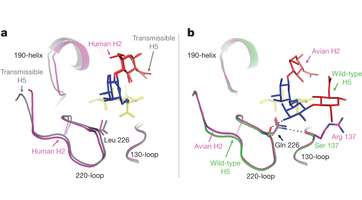April 25, 2013 report
Mutant version of H5N1 flu virus found to be more preferential to human infection

(Medical Xpress)—An international team of bio-researchers has found that a mutant strain of the H5N1 influenza virus (created in a lab) has a 200-fold preference for binding with receptors in human cells, over those found in birds. In describing their research and conclusions in their paper published in the journal Nature, the researchers suggest that the mutant variant is much more like the strains of viruses that caused pandemics in 1918, 1957 and 2009, than it was in its native state.
In its native state, according to the CDC, the H5N1 flu virus is highly contagious and is especially deadly to birds. Fortunately, few people have contracted this strain of flu as it's quite deadly in people as well. Luckily, there have been very few cases of transmission of the virus between people, indicating that the protein the virus variant uses to bind to human cells is quite weak. That does not appear to be the case, however, for a mutant version of the virus created by Japanese scientists last year.
In that effort, the Japanese team mutated the hemagglutinin gene in a sample of H5N1 and then mixed it with genes from the H1N1 flu variant (the virus behind the 2009 swine flu pandemic). The hemagglutinin gene is responsible for causing the virus to create the proteins that allow for bonding to host cells. The purpose of the experiment was to create a virus that would be both deadly and highly contagious in humans, so that a means could be developed to defeat such a threat before it arose in the natural world.
In this new effort, the research team found that the proteins produced by the mutated version of the H5N1 held a 200-fold preference to bind with human cells over avian cells. This suggests, the researchers claim, that the mutated virus is much more like the viruses that caused earlier pandemics, and is thus much more of a threat to humans than the natural variant. The inference is that if H5N1 mixed (by having a single host become infected with both viruses at once) with other influenza viruses naturally, than there exists the possibility of a natural version of the mutant virus coming to exist and a very real threat to the health of humans across the globe.
The researchers are taking what they've learned about the H5N1 mutant and applying it to H7N9—a new flu variant that has to date killed over a hundred people in China.
More information: Receptor binding by a ferret-transmissible H5 avian influenza virus, Nature (2013) doi:10.1038/nature12144
Abstract
Cell-surface-receptor binding by influenza viruses is a key determinant of their transmissibility, both from avian and animal species to humans as well as from human to human. Highly pathogenic avian H5N1 viruses that are a threat to public health have been observed to acquire affinity for human receptors, and transmissible-mutant-selection experiments have identified a virus that is transmissible in ferrets1, 2, 3, the generally accepted experimental model for influenza in humans. Here, our quantitative biophysical measurements of the receptor-binding properties of haemagglutinin (HA) from the transmissible mutant indicate a small increase in affinity for human receptor and a marked decrease in affinity for avian receptor. From analysis of virus and HA binding data we have derived an algorithm that predicts virus avidity from the affinity of individual HA–receptor interactions. It reveals that the transmissible-mutant virus has a 200-fold preference for binding human over avian receptors. The crystal structure of the transmissible-mutant HA in complex with receptor analogues shows that it has acquired the ability to bind human receptor in the same folded-back conformation as seen for HA from the 1918, 1957 (ref. 4), 1968 (ref. 5) and 2009 (ref. 6) pandemic viruses. This binding mode is substantially different from that by which non-transmissible wild-type H5 virus HA binds human receptor. The structure of the complex also explains how the change in preference from avian to human receptors arises from the Gln226Leu substitution, which facilitates binding to human receptor but restricts binding to avian receptor. Both features probably contribute to the acquisition of transmissibility by this mutant virus.
© 2013 Phys.org















